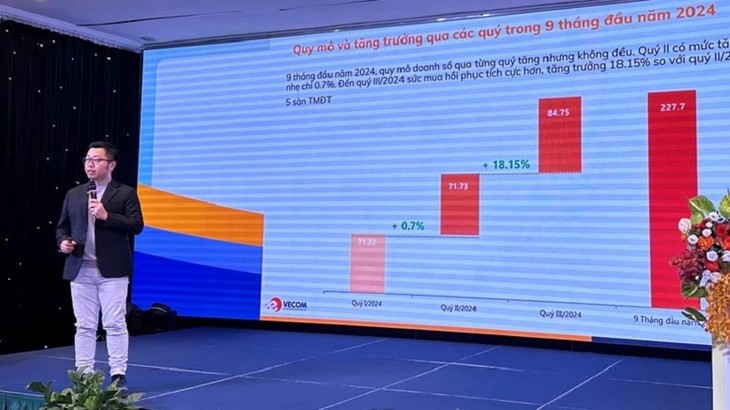(VOVWORLD) - The e-Economy SEA 2024 report jointly released by Google, Temasek, and Bain & Company estimates that Vietnam’s e-commerce market will reach 22 billion USD this year. This presents a significant opportunity for Vietnamese businesses and “Made in Vietnam” products to thrive in the digital landscape.
 Workshop “Empowering Vietnamese goods on e-commerce platforms”. Photo: (nhandan.vn) Workshop “Empowering Vietnamese goods on e-commerce platforms”. Photo: (nhandan.vn)
|
Photo 2: Representative of Vietnam E-commerce Association presents shopping trends via e-commerce channels, difficulties and challenges for Vietnamese enterprises. Photo: Nhan Dan Newspaper
Accounting for over 60% of Vietnam’s digital economy, e-commerce is a primary growth driver along with online tourism. The Vietnamese e-commerce scene is dominated by domestic platforms like Shopee, TikTok Shop, Lazada, Tiki, and Sendo, but is seeing the rise of cross-border platforms like Temu and Shein. To increase their competitiveness, Vietnamese businesses are leveraging artificial intelligence, capitalizing on industry strengths, and adopting new sales methods.
 Representative of Vietnam E-commerce Association presents shopping trends via e-commerce channels, difficulties and challenges for Vietnamese enterprises. Photo: nhanda.vn) Representative of Vietnam E-commerce Association presents shopping trends via e-commerce channels, difficulties and challenges for Vietnamese enterprises. Photo: nhanda.vn) |
Le Hoang Oanh, Director of the Department of E-commerce and Digital Economy at the Ministry of Industry and Trade, said: "E-commerce is a pioneering field of the digital economy, driving economic growth and leading the digital transformation in businesses. In the dynamic landscape of the global economy, businesses need to adapt to evolving consumer needs."
At the workshop "Supporting Vietnamese Goods on E-Commerce Platforms," hosted by the Young Age newspaper and the Vietnam E-commerce Association (VECOM) in Ho Chi Minh City on Wednesday, Nguyen Minh Duc, Deputy General Secretary of VECOM, said several initiatives to empower Vietnamese businesses have been implemented, including livestreaming sales in digital markets, building online profiles for businesses, partnering with platforms like TikTok Shop and Shopee to train employees, and promoting cashless payments.
Mr. Duc urged businesses to use advertising channels, livestreaming, and AI tools as cross-border e-commerce expands to reach a global market of 8.1 trillion USD. He said Vietnamese businesses need to closely follow global trends to make e-commerce more effective.
Nguyen Xuan Thao of the Vietnam Logistics Services Association (VLA) said that, to bolster competitiveness, logistics solutions are vital. This includes developing a logistics ecosystem and a green supply chain, using electric motorbikes for last-mile delivery to reduce traffic congestions, being more environmentally friendly, promoting the image of Vietnamese goods, and using AI and machine learning for efficient tracking and origin verification of goods.
On the business side, KOL Diep Le highlighted the advantages of Vietnamese businesses doing e-commerce in Vietnam compared to internationally. With no language barrier, Vietnamese businesses can provide seamless customer service and enhance the consumer experience—from livestream sales to speedy and reliable delivery. She suggested creating comprehensive product information libraries to enable customers to verify product origins, reinforce trust in Vietnamese goods, and increase Vietnamese businesses’ competitiveness.